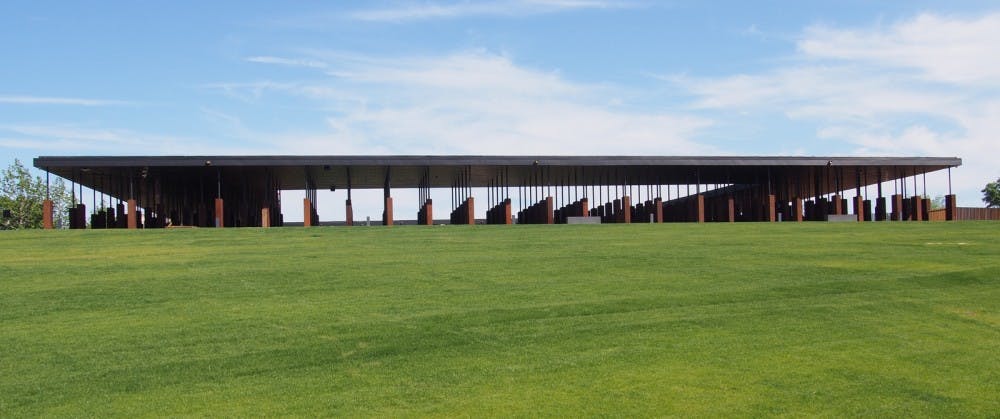Beyond the slight crackling of gravel, not much is heard, yet there is a deafening scream visitors can't help but register while walking toward the black statue of a woman on her knees, chained around the neck, screaming and staring at the ground they walk on.
This ground is in Montgomery, home of The National Memorial for Peace and Justice, a site founded by Equal Justice Initiative and dedicated to the legacy of enslaved black people who, after emancipation, were terrorized by systemic racial lynching. Over 4400 African Americans were hanged, burned, shot, drowned, stabbed and beaten to death, according to EJI. EJI also notes that many of those killed will never be known.
In Lee County, four men’s lives were ended from lynching. Their names, etched across rusted steel, await the gaze of visitors whose eyes speak more than their mouths ever could when looking at the monument.
It's 89 degrees that with “a touch of southern special humidity,” as one security guard put it, makes it feel 98. Sweat crawls all over the skin like nagging insects, and the grey shirt of a little boy becomes darker as he swipes away mosquitoes. There is no shade before walking up a slight hilltop that houses steel structures with the lynching victims’ names. Each steel monument represents a county in the South.
Downtown Montgomery can be seen from the memorial, and the monuments loom above like an overcast sky. On trek, visitors can see hints of what the monuments represent.
Perhaps the anguish felt when seeing those dangling steel structures is best expressed by the boy in the grey shirt. He looks up, pokes his mother’s hip and asks, “Mommy, why did they hang them like this?”
The symbolism is clear enough for children to be cognizant of what happened in this country and seemingly powerful enough to make your own throat tighten with grief.
There are over 800 steel monuments, according to EJI. Finding a specific county requires sifting through a rustic maze of solidified murder and hatred. Silver plaques alongside a black wall tell of hundreds of people being present for the lynching, and in other instances, thousands.
A photograph shows black legs suspended in the air as men and their sons look on with casual faces. There’s no look of disgust, no creases on their forehead or squint in their eyes — just a point-blank stare. In fact, one man in the background of the picture is smiling.
Lee County’s remembrance monument is located near the entrance of the memorial, closest to the unshaded area. From a distance, the rusted structure looks clay colored. Only up close can the various reds, browns and oranges be seen.
The monument is hollow, casting a darkness within that illuminates the four punctured names:
JOHN HART – 11.03.1886
GEORGE HART – 11.05.1887
CHARLES HUMPHRIES – 03.18.1900
SAMUEL HARRIS – 11.03.1902
Because of information available at American Lynching Data, which uses a historic newspaper database from Tuskegee University and Project HAL, we know why these four men were brutally lynched in Lee County. John Hart was wrongly accused of murder; George Hart was wrongly accused of murder; Charles Humphries was wrongly accused of attempted rape; Samuel Harris was wrongly accused of murderous assault, all according to American Lynching Data.
Various people pause to reflect, one of whom is Robin Levinson. She is from Dothan, Alabama, but lived in Auburn for a while, she said. She wanted to visit the memorial with her husband before they leave for California in a few weeks. Her grandparents and mother are from Lee County, and she has uncles and cousins living there now, she said.
“It’s really shocking. I didn’t have any concept of this history when I lived there,” Levinson said. “If I had to guess, I doubt my family has any idea, so I want to make sure they know what I saw here today.”
And that vision surrounds her. There are people pointing at each individual name on the structures, trying to tally up the number of people slain by racial terror. On some counties the list is so long, people lose track and start again from the top.
To David Carter, associate professor of history at Auburn, those names must make one ask: what kind of culture tolerated this?
“While this was primarily a southern phenomenon, there’s no doubt that horrific choices were made across the country, so really, this is a national crime,” Carter said.
The written text at the memorial does not shy away from telling this crime.
“The language doesn’t mince words. It uses this phrase ‘terror lynching,’ and it clearly conveys that lynching is a form of terrorism,” Carter said.
Carter acknowledges that some people will see this memorial as an act of political correctness or America picking at its scab of national history, but he doesn’t see it that way.
“People will tell me, ‘oh that stuff isn’t pleasant to think about; won’t we be better of as a nation if we focus on making the present better and making the future better?’ But I’m just of that mind, like archbishop Tutu of South Africa, that you cannot look forward to a multiracial future unless you’re willing to acknowledge the past you’ve inherited,” Carter said.
The past echoes when leaving the memorial. On the ground are replica steel monuments resembling caskets. The monuments "await to be claimed and installed in the counties they represent," as it states on the EJI website. Those interested in bringing the monument back to Lee County can go on eji.org and fill out the memorial monument inquiry form.
For now, the steel hangs as a testament of terror, and the Lee County monument awaits to be taken across the state, across historic confederate markers scattered throughout, across oak-bordered highway and Camellia covered land. It hangs in the shade, awaiting Alabama’s scorching sunlight to shine these four names: John Hart, George Hart, Charles Humphries and Samuel Harris.
Do you like this story? The Plainsman doesn't accept money from tuition or student fees, and we don't charge a subscription fee. But you can donate to support The Plainsman.





